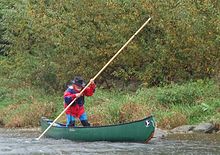Canoe Poling
Canoe Poling (from English canoe : canoe / canoe ; pole : pole / stick) describes the technique of pinning a canoe standing in shallow sections of the river against the current . When poling you stand behind the middle of the boat. This relieves the bow and makes it easier to direct. The pole is placed on the river bed to the side of the boat. Then you shimmy along the pole - similar to the punt - until the end of the pole is reached and it is lifted out of the water and led forward again. This process can be carried out in different ways: The rod can be brought in with a throwing motion or it can be reinserted with the end sticking out of the water (windmill technology).
At the time of the voyageurs, easy rapids were overcome by means of poling . This saved a long and cumbersome portage .
The same technique can also be used downstream. It is then referred to as "snubbing". You stand further forward in the bow so that the upstream stern is relieved, which could otherwise easily be swept around by the current.
Traditional pole poles are made of wood. With traditional poling, you stand diagonally in the boat and guide the pole only on one side. Competitive poling is operated with aluminum or fiberglass poles. You stand across the boat with your legs apart and - depending on the requirements of the flowing water - change the side on which the pole is put into the water.
